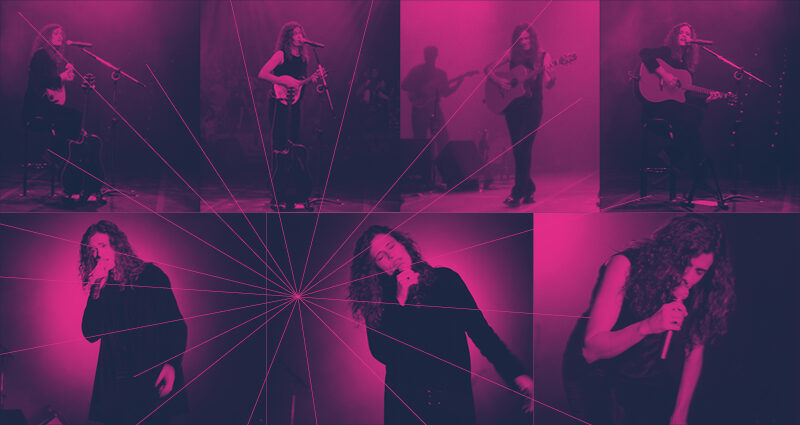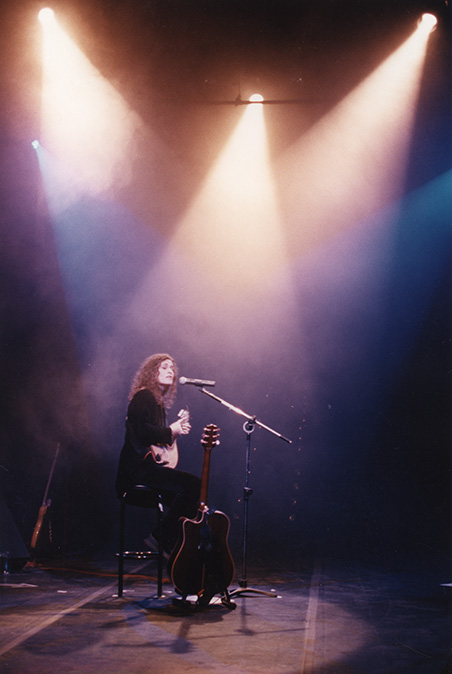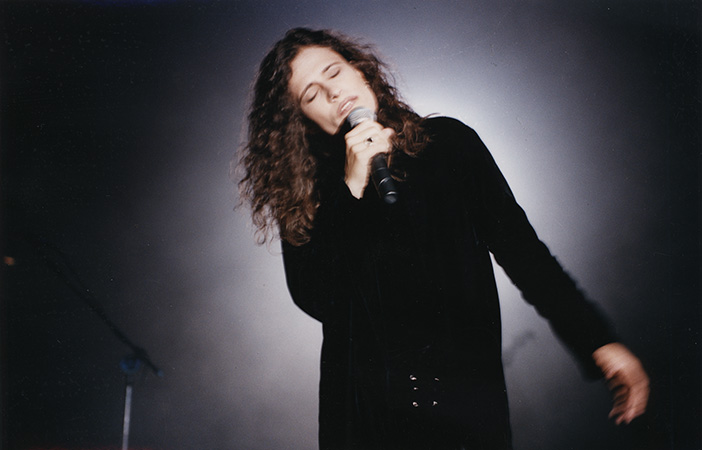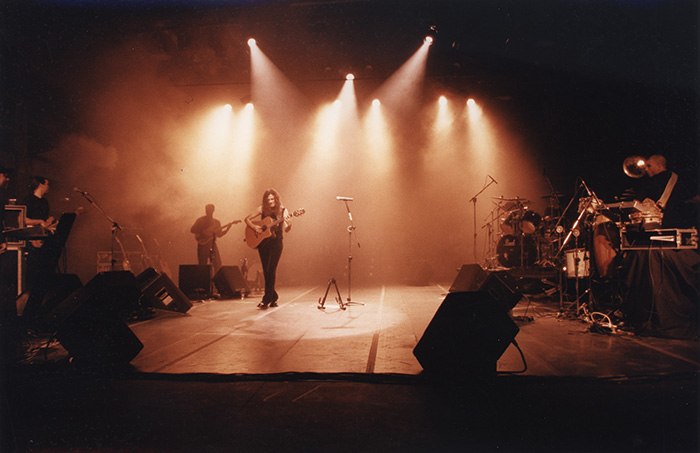
Zélia Duncan had released her third album, “Intimidade”, the year before, when she took the stage at Sesc Pompeia on Tuesday, July 15, 1997. It was her first album after the success of “Catedral”, and it showed that her success would not be fleeting. She was there to take part in the project “Ouvindo Estrelas” (Listening to the Stars) at Sesc Pompeia, directed by journalist and musical researcher Zuza Homem de Mello, of whom she was a friend. The evening began with a lovely chat of about 20 minutes, and then Zélia introduced herself.
With songs from her second and third albums, “Zélia Duncan” (1994) and the aforementioned “Intimidade” (1996), the artist showed not only her strength as a singer, with her remarkable deep voice, but also as a songwriter, since 14 of the 19 tracks were written by her, alone or in partnership. It was a moment of consecration in her career, registered in the album “Relicário: Zélia Duncan (ao vivo no Sesc 1997)”, the second release of the project Relicário, from Sesc label, which arrives to the public now, more than two decades later.
That stage was a watershed in the artist’s career: it was there, three years earlier, the first time Zélia had heard the audience sing along in one of her performances. A night she remembers to this day. “I will never forget it, because it was just before that explosion, but the countdown was already open. The album ‘Zélia Duncan’, which contained ‘Catedral’ and so many songs that were important to me, had been released in 1994. This show must have been a few months later, and you feel the wave changing, you know? There was a frisson in the air and people coming. It was the end of loneliness, at least in this aspect”, she remembers.



The affection of the São Paulo public was such that the singer even said in an interview to Folha, in 1997, that São Paulo was the best place for her music and that many people thought she was from São Paulo. Nowadays, she believes that it was her artistic identification with São Paulo that left this impression. “My biggest idol is Itamar Assumpção, and I have always made that very clear. Singing Rita Lee and Itamar with so much love confused people, but I was born in Niterói, was raised in Brasília, and Rio became my home”, she laughs.
At the 1997 performance, things had already changed a lot. Zélia had recently done a show in Central Park, New York, a mini-tour in Europe, and “Intimidade” had just won a gold record for 100,000 copies sold. “It was a moment of ascension of my career, the ‘boom’. I had never even been to New York, mind you. It was very important as part of a whole, which was very new to me,” says the singer.
It was in the midst of this good wave (and nothing temporary – on the contrary) that she went to meet the Sesc Pompeia audience once again, accompanied by Ezio Filho (bass and musical direction), Ricardo Brasil (percussion), Wallace Cardia (drums), Luis Hiroshi (keyboards), and Luiz Chaffin (guitar, acoustic guitar, and mandolin). “I remember my entrance, that good buzz in the ear, when the audience wants to show that they love you. I remember the hug with Zuza, I remember how happy I was,” remembers Zélia.
“Boomerang Blues”, by Renato Russo, opens the presentation – which, by the way, splices in another song by the singer and composer, “Quase Sem Querer” (by Renato with Dado Villa-Lobos and Renato Rocha). “My generation was very much invaded by national pop rock, and Legião, like me, coming somewhat from Brasília, called me even more. Renato is an icon for us,” comments the singer. The song is also a cover: “Lá Vou Eu”, by Rita Lee and Luis Sérgio Carlini, from the soundtrack of the soap opera “O Grito” (1976). “This song started playing on Rádio Musical1 and spread out, even today people think it is mine, because it became my face with São Paulo”, says Zélia.
Before singing the song, in voice and acoustic guitar format, Zélia speaks again about the importance of Sesc Pompeia in her career, addressing the audience. “As Zuza said, this stage here is very important for me. That year I came for the first time and had the impression that the public was singing with me. A wonderful impression, that one. And the song was ‘Lá Vou Eu’, by Rita Lee and Luis Sérgio Carlini, that we now repeat, together, for real, without illusions”, says the artist in the recording.
At the end of the number, in another interaction with the audience, the singer takes up a story she had mentioned during the chat with Zuza Homem de Mello: when “Catedral” was a hit, many people were in doubt whether the voice they were hearing was that of a man or a woman. She then understood that she needed to do shows and “run after” her voice, which was reaching the public before her, before her image. “It used to happen that people would hear me on the radio, call in, then ask, ‘Who is this guy?’ So it was time to go out there and sing and explain to people that the guy was me,” she jokes.
The first track in the show is “Não vá ainda”, with Christiaan Oyens (one of her most frequent partners), from “Zélia Duncan” (1994), only with voice and mandolin, which sounds even more delicate live. From this album, besides the already mentioned “Lá Vou Eu”, Zélia also presents “Tempestade” (hers with Oyens) – with Chico Science’s “A Cidade” as incidental music -, “Am I Blue For You” (by Joan Armatrading), “Sentidos” (with Oyens), “Nos Lençóis desse Reggae” (with Oyens) and “Catedral” (version of the German singer Tanita Tikaram’s hit, performed by Christiaan Oyens and Zélia Duncan).
From “Intimidade”, the first one she brings to the Sesc Pompéia stage is “Enquanto Durmo”, the fifth song of the show. At the time, the song’s videoclip had received five nominations for the Video Music Brasil, MTV’s award, including that of videoclip of the year. At 33, Zélia used to tell in interviews that she was surprised with the amount of young people in her shows. That night was no different. “It was an audience my age and younger than me,” she recalls.
Other songs from the 1996 album present in the show are “Não tem volta”, “Minha fé”, “Coração na boca”, “Experimenta”, “Vou tirar você do dicionário” (by Itamar Assumpção) – with quotes from “Barato Total” (Gilberto Gil) and “S.O.S.” (by Maurício Pacheco, success of the group Mulheres Q Dizem Sim) -, the title track, “Bom pra você”, “Assim que eu gosto” and “A diferença”, with reference to “Holiday Rap”, by MC Miker G and DJ Sven2.
Although Zélia had one more album, “Outra Luz” (1990), the singer did not identify much with the work, for not having stopped some impositions of the producers, such as the excess of keyboards. “I didn’t know how to say certain no’s that I needed to say. I started singing in ’81 and only went on to make the record in ’90. I was already anxious to have a work. I was afraid I wouldn’t get it done if I said no too much. I love that it exists, but it has nothing to do with me today”, she told Folha de S. Paulo in 1996.
In the second and third albums, however, the artist found the sound she wanted: a mixture of the good old MPB with folk and blues, with hints of country and reggae, crowned by the remarkable voice of the singer. The recipe pleased the public and the critics: the American magazine Billboard included “Zélia Duncan” (1994) in the list of the Ten Best Latin Albums of that year. Months later, “Catedral” was included in the soundtrack of the soap opera “A próxima vítima” (1995), as theme song of the character Irene (Vivianne Pasmanter). From then on, she began to reap the fruits of a career that had been going on for over a decade. “I worked hard, doing backing vocals, singing at night, even doing voiceovers, I went to the United Arab Emirates (between 1991 and 1992) to sing for five months. When I came back, life started to change,” remembers the singer.
With the next work, there was tension about how the record would be received, which usually happens with any artist who has just had her first success. Zélia says she felt anxiety “all the time.” “Only time has quieted me from certain afflictions. We have no control over anything except what we compose and sing. We can’t predict how it will be received, we need to perfect what comes out of us for the public, that’s what I’ve always known,” she says.



But the pressure, fortunately, didn’t take away the artist’s creative freedom, and “Intimacy” came out the way she would have liked. “I’m very proud of it, because you don’t find there the attempt to repeat myself. There is nothing like ‘Cathedral’ on it, there is a confirmation of the partnership with Christiaan Oyens and Lucina, my most frequent partners until then,” she celebrates.
The last song of the “regular time” is “Nos lençóis desse reggae” (In the sheets of this reggae) – with a quotation from “Roses Are Red (My Love)”, by Al Byron and Paul Evans -, which the public cheerfully accompanies. At the end, Zélia says: “Unforgettable. Thank you very much, once again,” she says. With ovations, she answers the requests for an encore – which, of course, brought the hit “Catedral”. The public accompanies her singing and clapping along to the rhythm, in a cathartic moment. Zélia even lets her fans sing the song themselves: “Sing for me, go”, she asks.
The result is a moving record, marked by the chemistry between the fans and the artist. “I love the stage. It is where I feel the best in life, even today. The audience instigates and stimulates me,” says Zélia. “And I was in my moment, the recording we are releasing together is a beautiful document, for me, of my complicity with this audience that opened its ears and heart to me,” gushes the singer.
Zuza Homem de Mello (1933-2020) was a journalist, music researcher and producer, curator, and concert director. Between 1994 and 1997 he presented the project “Listening to the Stars” at Sesc Pompéia, with chats and concerts with artists such as Maria Bethânia, Ivan Lins, João Bosco, Gil Costa and Gilberto Gil. With Zélia Duncan, the conversation was light, relaxed and very funny, showing how close the two had become.
When he called the artist to the stage, he observed that, decades before, Brazilian music was dominated by male interpreters. With a scenario dominated by women, it had become much more difficult to become a prominent singer. “However, Zélia managed that. First, she achieved this at the cost of tremendous effort and a confidence in herself,” he said. “She knew how to use her voice, which, without a doubt, is very original, low, with a very personal and identifiable timbre, which helps a lot, but she knew how to make a climate, a repertoire. Despite only three records, she is one of the most beloved stars in Brazil”.
Zuza remembered the difficult phase in the artist’s career, when she participated in a festival he was the director of and he encouraged her. “I said: ‘Zélia, you will get there, and it won’t be long (laughs)’. The singer answered with a compliment: “You were a relief in the middle of all that, you were someone who always told me something good. When you have no perspective and everything is getting harder, it is good to find someone who believes in you. It’s a lot,” she said. “I believe a lot, I always have, and more and more,” he added.
The artist told a little about what she grew up listening to: bossa nova and singers like Dick Farney and Francisco Alves, whose songs her mother liked to sing; Led Zeppelin and Pink Floyd, sound that came out of her brothers’ bedroom, and the album “Chico Buarque & Maria Bethânia ao vivo” (1975), a cassette tape she got from an uncle when she was 12. She, her mother, and her sister used to sing and record on a tape recorder. One day, Zélia took the hidden device and recorded “Tatuagem” (by Chico Buarque and Francis Hime) by herself, she said, giving a glimpse of the song.
The journalist mentions the recording of this song by Elis (in 1976, on the album “Falso brilhante”), and that is the cue for Zélia to talk about her admiration for the singer, whom she tried to imitate in her adolescence. “And I was desperate, because she sang much more high-pitched, and I wanted to sing pau a pau there with her (laughs). And my brothers would get desperate, because I would lock myself in my room and keep shouting the songs”, she amuses herself. Another talk, singing and playing the guitar, was “Doce de coco”, choro by Jacob do Bandolim with words by Hermínio Bello de Carvalho, recorded by Elizeth Cardoso, which was in the repertoire of Zélia’s previous tour.
In another amusing story, the singer told that, right after “Catedral” was released, she went to Curitiba to promote her second album, “Zélia Duncan” (1994). The artist was in a store looking at records when a person came in and said: “I am looking for a record… A voice that is in the soap opera. “Then I went closer to listen to it. Then the woman said: ‘Is it a man or a woman?’ ‘I don’t know. I said: ‘It is me!'”, Zélia said, to general laughter. “And it was (laughs),” she added.
The participation in the project “Ouvindo Estrelas” was important for the artist not only for her relationship with the stage of Sesc Pompeia, but also with the host himself. Before presenting “Minha fé”, she dedicates the song to the journalist. “I am touched by your question, because Zuza was a friend that music gave me. The fact that he liked me gave me prestige, he was full of dignity and knew the history of things. He looked me in the eye, and that generous smile invaded my life. He always gave me a lot of strength, I felt safe with him.
1 Operating on the 105.7 MHz frequency, between 1989 and 1999 Rádio Musical became known in São Paulo for dedicating all its programming to MPB, and helping to reveal new artists. Then it changed its profile.
2 In the studio recording of the song, the quote is attributed to “Summer Holiday” by B. Bennet and B. Welsh. However, the lyrics sound more like “Holiday Rap”, which is an interpolation of “Summer Holiday”, i.e. it has partially different lyrics to the melody of the song.
Kamille Viola is a journalist and music researcher. She wrote the book “África Brasil: um dia Jorge Ben voou para toda a gente ver”, by Edições Sesc.
About Relicário: Zélia Duncan (Ao vivo no Sesc 1997), you may also read:
Utilizamos cookies essenciais para personalizar e aprimorar sua experiência neste site. Ao continuar navegando você concorda com estas condições, detalhadas na nossa Política de Cookies de acordo com a nossa Política de Privacidade.